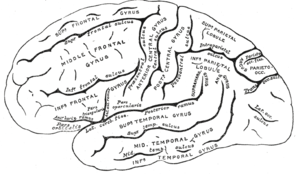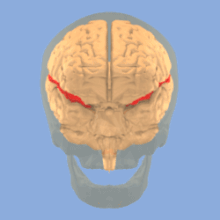Sulcus (neuroanatomy)
| Sulcus | |
|---|---|
 Sulcus and gyrus | |
| Identifiers | |
| NeuroNames | 1208 |
| TA98 | A14.1.09.006 |
| TA2 | 5433 |
| FMA | 75759 |
| Anatomical terminology | |




In neuroanatomy, a sulcus (Latin: "furrow"; pl.: sulci) is a depression or groove in the cerebral cortex. It surrounds a
Structure
Sulci, the grooves, and gyri, the folds or ridges, make up the folded surface of the cerebral cortex. Larger or deeper sulci are termed fissures, and in many cases the two terms are interchangeable. The folded cortex creates a larger surface area for the brain in humans and other mammals. When looking at the human brain, two-thirds of the surface are hidden in the grooves. The sulci and fissures are both grooves in the cortex, but they are differentiated by size. A sulcus is a shallower groove that surrounds a gyrus. A fissure is a large furrow that divides the brain into lobes and also into the two hemispheres as the longitudinal fissure.[1]
Importance of expanded surface area
As the surface area of the brain increases more functions are made possible. A smooth-surfaced brain is only able to grow to a certain extent. A depression, sulcus, in the surface area allows for continued growth. This in turn allows for the functions of the brain to continue growing.[2]
Variation
The sulcal pattern varies between human individuals, and the most elaborate overview on this variation is probably an atlas by Ono, Kubick and Abernathey: Atlas of the Cerebral Sulci.[3] Some of the more prominent sulci are, however, seen across individuals – and even species – making a common nomenclature across individuals and species possible.
Development
In humans, cerebral convolutions appear at about five months and take at least into the first year after birth to fully develop.[4][5][6] Development varies greatly between individuals. The potential influences of genetic, epigenetic and environmental factors are not fully understood.[7] It has been found that the width of cortical sulci increases not only with age,[8] but also with cognitive decline in the elderly.[9]
Types
Sulci are divided into the following categories:[citation needed]
On the basis of function:
- A limiting sulcus separates at its floor into two areas which are different functionally and structurally e.g. central sulcus between the motor and sensory areas.[10]
- Axial sulcus develops in the long axis of a rapidly growing homogeneous area e.g. postcalcarine sulcus in the long axis of the striate area.
- Operculated sulcus separates by its lips into two areas and contains a third area in the walls of the sulcus e.g. lunate sulcus is an operculated sulcus, separating the striate and parastriate areas.
On the basis of formation:
- Primary sulci: formed before birth, independently. Example: central sulcus.
- Secondary sulcus: produced by factors other than the exuberant growth in the adjoining areas of the cortex Examples are the lateral and parieto-occipital sulci.
On the basis of depth:
- Complete sulcus is very deep so as to cause elevation in the walls of the lateral ventricle. Examples are the collateral and calcarine sulci.
- Incomplete sulci are superficially situated and are not very deep, E.g. paracentral sulcus.
Notable sulci
- Calcarine sulcus
- Central sulcus
- Central sulcus of insula
- Cingulate sulcus
- Circular sulcus of insula
- Callosal sulcus
- Collateral sulcus
- Fimbrodentate sulcus
- Florance-robertal sulcus
- Hippocampal sulcus
- Inferior frontal sulcus
- Inferior temporal sulcus
- Intraparietal sulcus
- Lateral sulcus
- Lunate sulcus
- Occipitotemporal sulcus
- Olfactory sulcus
- Paracentral sulcus
- Parieto-occipital sulcus
- Postcentral sulcus
- Precentral sulcus
- Rhinal sulcus
- Subparietal sulcus
- Superior frontal sulcus
- Superior temporal sulcus
- Transverse occipital sulcus
- Transverse temporal sulcus
Other animals
The variation in the number of fissures in the brain (
Macaque
A macaque has a more simple sulcal pattern. In a monograph Bonin and Bailey list the following as the primary sulci:[12]
- Calcarine fissure(ca)
- Central sulcus (ce)
- Sulcus cinguli (ci)
- Hippocampal fissure(h)
- Sulcus intraparitalis(ip)
- Lateral fissure(or Sylvian fissure) (la)
- Sulcus olfactorius(olf)
- Medial parieto-occipital fissure(pom)
- Fissura rhinalis(rh)
- Sulcus temporalis superior(ts) – This sulcus runs parallel to the lateral fissure and extends to the temporal pole and often superficially merges with it.
See also
References
- ^ Carlson, N. R. (2013). Physiology of Behavior. Upper Saddle River, NJ: Pearson Education Inc.
- ^ Cusack, R. (2005). The intraparietal sulcus and perceptual organization. Journal of Cognitive Neuroscience, 17(4), 641–651. doi: 10.1162/0898929053467541
- ISBN 3-13-732101-8.
- ^ PMID 3836731
- ^ PMID 2645619
- ^
Caviness VS Jr. (1975). Mechanical model of brain convolutional development. Science. 189(4196):18–21. PMID 1135626
- ^ Dubois, J., & Benders, M. (2007). Mapping the early cortical folding process in preterm newborn brain. Oxford Journals, 18, 1444–1454. dpi: 10.1093/cercor/bhm180
- ^
Tao Liu, Wei Wen, Wanlin Zhu, Julian Trollor, Simone Reppermund, John Crawford, Jesse S Jin, Suhuai Luo, Henry Brodaty, Perminder Sachdev (2010) The effects of age and sex on cortical sulci in the elderly. PMID 20156569
- PMID 21397704
- PMID 20121437.
- Current Opinion in Neurobiology15:135–144, (2005).
- ^ Gerhardt von Bonin, Percival Bailey, The Neocortex of Macaca Mulatta, The University of Illinois Press, Urbana, Illinois, 1947
